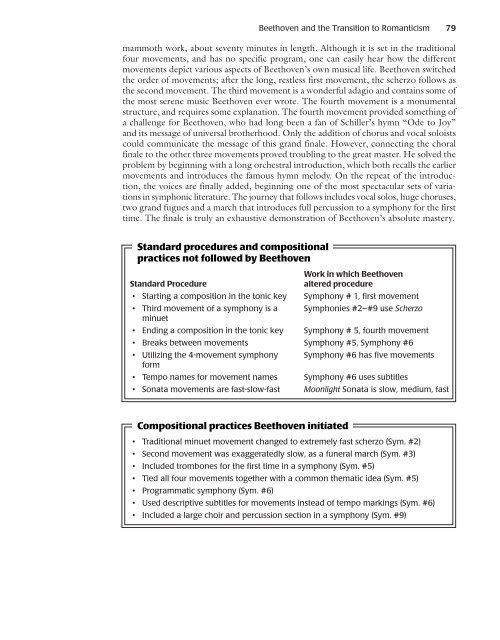Composer Profile - Activefolio
Composer Profile - Activefolio
Composer Profile - Activefolio
Create successful ePaper yourself
Turn your PDF publications into a flip-book with our unique Google optimized e-Paper software.
Beethoven and the Transition to Romanticism 79<br />
mammoth work, about seventy minutes in length. Although it is set in the traditional<br />
four movements, and has no specific program, one can easily hear how the different<br />
movements depict various aspects of Beethoven’s own musical life. Beethoven switched<br />
the order of movements; after the long, restless first movement, the scherzo follows as<br />
the second movement. The third movement is a wonderful adagio and contains some of<br />
the most serene music Beethoven ever wrote. The fourth movement is a monumental<br />
structure, and requires some explanation. The fourth movement provided something of<br />
a challenge for Beethoven, who had long been a fan of Schiller’s hymn “Ode to Joy”<br />
and its message of universal brotherhood. Only the addition of chorus and vocal soloists<br />
could communicate the message of this grand finale. However, connecting the choral<br />
finale to the other three movements proved troubling to the great master. He solved the<br />
problem by beginning with a long orchestral introduction, which both recalls the earlier<br />
movements and introduces the famous hymn melody. On the repeat of the introduction,<br />
the voices are finally added, beginning one of the most spectacular sets of variations<br />
in symphonic literature. The journey that follows includes vocal solos, huge choruses,<br />
two grand fugues and a march that introduces full percussion to a symphony for the first<br />
time. The finale is truly an exhaustive demonstration of Beethoven’s absolute mastery.<br />
Standard procedures and compositional<br />
practices not followed by Beethoven<br />
Standard Procedure<br />
Work in which Beethoven<br />
altered procedure<br />
Starting a composition in the tonic key Symphony # 1, first movement<br />
Third movement of a symphony is a<br />
minuet<br />
Symphonies #2–#9 use Scherzo<br />
Ending a composition in the tonic key Symphony # 5, fourth movement<br />
Breaks between movements Symphony #5, Symphony #6<br />
Utilizing the 4-movement symphony<br />
form<br />
Symphony #6 has five movements<br />
Tempo names for movement names Symphony #6 uses subtitles<br />
Sonata movements are fast-slow-fast Moonlight Sonata is slow, medium, fast<br />
Compositional practices Beethoven initiated<br />
Traditional minuet movement changed to extremely fast scherzo (Sym. #2)<br />
Second movement was exaggeratedly slow, as a funeral march (Sym. #3)<br />
Included trombones for the first time in a symphony (Sym. #5)<br />
Tied all four movements together with a common thematic idea (Sym. #5)<br />
Programmatic symphony (Sym. #6)<br />
Used descriptive subtitles for movements instead of tempo markings (Sym. #6)<br />
Included a large choir and percussion section in a symphony (Sym. #9)



